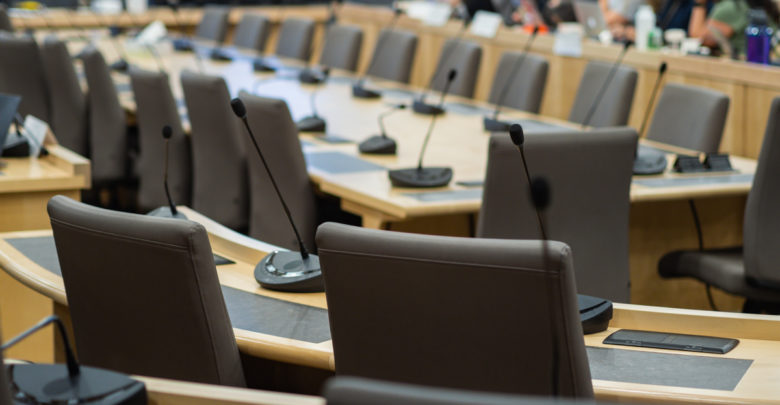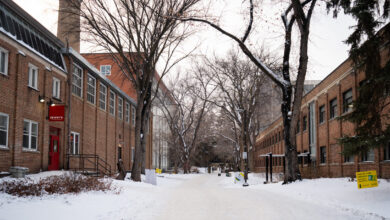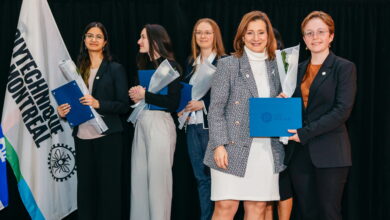Notes from Council: Residential School Memorial presented to council, ESA receives feedback on FAMF proposal
The November 16 Students' Council meeting included a presentation on a Residential School Memorial on North Campus's Main Quad, and a proposal from the Education Students' Association's for renewing their Faculty Association Membership Fee.
 Helen Zhang
Helen Zhang“Notes from Council” is The Gateway’s ongoing series of recaps of noteworthy items from Students’ Council meetings.
Councillors present on Residential School Memorial
The November 16 Students’ Council meeting began with Julia Villoso, chair of Council Administration Committee (CAC) and Vaughn Beaulieu-Mercredi, Aboriginal Relations & Reconciliation Committee (ARRC) chair and president of the Aboriginal Students’ Council (ASC), presenting to Students’ Council on the Residential School Memorial at the University of Alberta. Both Villoso and Beaulieu-Mercredi are also arts councillors on Students’ Council.
Villoso credited a memorial at Augustana Campus honouring residential school survivors as the inspiration behind organizing a similar memorial for North Campus. The memorial at Augustana Campus had a number of flags planted in the ground, many of them displaying the names of residential schools.
The Augustana Campus memorial was organized by Victoria Delorme, the campus’s student experience coordinator for Indigenous Student Services. For the memorial on North Campus, Villoso expressed plans to plant 7,509 flags on Main Quad.
“We plan to plant 7,509 state flags in main quad,” she said. “3,200 will be orange [representing] the number officially recognized the Truth and Reconciliation Commission in [the Truth and Reconciliation Report], and we will have 4,309 red flags… symboliz[ing] that additional unmarked graves that have been discovered.”
According to Beaulieu-Mercredi, connecting the Calls to Action presented by the Truth and Reconciliation Commission to campus comes in the form of the Aboriginal Relations and Reconciliation Committee (ARRC). Beaulieu-Mercredi described AARC as a static committee at the Students’ Union that acts “as a liaison between Students’ Council and Aboriginal students at North Campus.”
During the presentation, Beaulieu-Mercredi discussed the 57 recommendations ARRC brought forward to the University of Alberta Students’ Union (UASU) following the 2018-19 academic year.
“There are 57 [recommendations], and about 10 per cent — or six recommendations — have not seen significant work or progress,” he said.
Beaulieu-Mercredi went over the current status of ARRC’s recommendations:
- 29 per cent (17) of the recommendations are listed as complete.
- 14 per cent (8) of the recommendations are ongoing.
- 45 per cent (26) of the recommendations are listed as in-progress.
- 5 per cent (3) of the recommendations are listed as initial planning.
- 5 per cent (3) of the recommendations are listed as not started.
Villoso and Beaulieu-Mercredi hope the memorial on Main Quad will to bring attention to these recommendations and to the affects of residential schools.
“When the news of the unmarked graves first came out at the beginning of summer, there was a large uproar all over social media and just generally [in the university] population,” Villoso said. “I think that uproar has slowly been dying out and losing attention. We really hope that through this memorial we can bring that attention and awareness back to the effects of residential schools.”
Beaulieu-Mercredi highlighted how residential schools are affecting current students today.
“Many Indigenous students still continue to be affected by residential schools here today… I’m one of those students,” he said.
He shared photos of his papa who was forced to attend St. Henri Indian Residential School, which operated in Port Vermillion.
“I think it’s significant that these pictures are in colour,” he said. “It shows that the period in which the schools operated are not in the distant past — but in fact are in the living memories of many people. Those people that have living memories of the school span both sides of my family… it’s evident that there are lasting legacies from the residential school period.”
ESA proposes FAMF renewal
After Villoso and Beaulieu-Mercredi concluded their presentation, the Education Students’ Association (ESA) presented their proposal to renew the Faculty Association Membership Fee (FAMF).
The association was represented by Edward Tiet, ESA vice-president (finance), and Rowan Morris, ESA vice-president (external). Morris is also an education councillor on Students’ Council.
Tiet presented Students’ Council with the FAMF’s primary purposes, which includes providing education students with membership in the Alberta Teachers’ Association (ATA). This membership is needed for accessing the ATA library, membership in ATA specialist councils, and attending teachers’ conventions — a requirement for fourth year education students.
The FAMF proposed for renewal is $8.00 per year until August 31, 2025.
“[The $8.00 fee] will be collected from both full time and part time [education] students in the Fall semester,” Tiet explained. “Of this fee, $1.00 will be forwarded to the [ATA] as payment for membership and a student [subgroup] — the rest would be used to improve services and events to students at the lowest cost possible.”
According to Tiet, the proposed fee would be allocated as follows:
- 25 per cent for saving for emergencies.
- 20 per cent for graduation.
- 15.5 per cent for administrative costs.
- 15 per cent for social events.
- 15 per cent for volunteer appreciation costs.
- five per cent for professional development events.
- three per cent for publicity and marketing.
- 1.5 per cent for conferences.
Emily Motoska, education councillor, asked if the ESA has a predicted percentage of education students that will choose to opt-out of the fee and how that will affect the predicted allocations presented earlier.
In response, Tiet said the ESA does not expect many education students to opt-out of the FAMF.
“We’re predicting not many students to opt-out, but if they decide to I guess we’ll cut down everything by a per cent or two for each of the sections,” he said.
Morris echoed Tiet’s prediction and said the ESA predicts a small percentage of education students to opt out.
“I think we’ll have to play that one by ear,” Morris added. “Typically when it comes to ESA involvement people are very eager to get involved. There [aren’t] as [many] professional development opportunities once you get into the workforce… and that’s something that [is very] sought after for education students.”
“We aren’t anticipating a large volume [of students] to opt-out.”
Simran Dhillon, science councillor, asked what the incentive was for students to opt-in to the fee. In response, Morris said the opt-out feature will not be explicitly advertised but will be there if students need it.
“I think what we’re going to do is not necessarily making it an advertised thing that the opt-out function exists,” Morris responded. “People who do need to opt-out obviously will be seeking that information out… but this will be something we will have to play by ear.”
“If we have a large amount of people considering to opt-out, that is something we will have to revisit with next year’s FAMF opt-out policy. We’re just going to have to wait and see with that unfortunately.”
The ESA will be presenting a revised proposal to Students’ Council at the next meeting.




